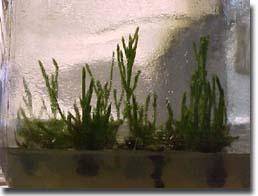CULTURAL PRACTICES FOR CASUARINA
LAND PREPARATION:
-
Prior to planting Casuarina, it should ensure that the selected site is well drained, without any water logging. The identified site should be thoroughly cleaned of weeds.
-
A pit of 2x2x2 ft and is filled with a pot mixture consisting of decomposed organic manure, de oiled neem cake and topsoil (kept aside during digging of pit). The pit mixture should be prepared by thoroughly mixing equal parts of organic manure and topsoil, along with 250 grams of de oiled neem cake. The pit mixture thus prepared should be used for filling the pit.

Casuarina Multiplying Culture
PIT FILLING & SPACING:
-
The pits are filled, as much as possible, only with the prepared pit mixture. If the topsoil is insufficient, coarse river sand can be used as an inert substitute, which also increases porosity.
-
A peg may be planted in the centre of the pit for identification during planting.
-
The pit must be filled 2-3 weeks before planting, to allow the pit mixture to settle.
-
The seedlings are planted in the pits with espacement of 1m x 1m in square planting method.
-
The seedlings should be inoculated with a biofertilizer known as Frankia, an actinomycetes which establishes symbiotic association with the root hairs of Casuarina and facilitates nitrogen fixation that consequently increase the biomass production.
IRRIGATION:
Watering has to be done immediately after planting. During the first two weeks watering should be done alternate day. Subsequent irrigation can be done once in 3 - 4 days depending upon the soil and weather conditions. In non-irrigated lands micro-irrigation systems can be installed.
FERTILIZER APPLICATION & DOSES:
Fertilizer is applied in 10 split doses.
-
The recommended dosage of fertilizer is 200:200:300 gm of N: P: K / plant /year.
-
This dose is applied throughout the year, except during the summer months of April - May.
-
During the second year, the dosage is reduced and applied in the same way.
-
In the following years fertilization is done only for alternative years.

Casuarina Culture
PLANT PROTECTION:
-
There is no such major pest noticed in this crop. Even if any disease infestation is noticed, a mild spray of Bavistin or any systemic insecticide is recommended.
-
To enhance rapid growth of the plant, spraying of plant growth regulator is advised.
PRUNING:
-
In Casuarina plantation, pruning of the side shoots must be undertaken to ensure minimum, straight growth of the tree. All the side shoots growing below 4.5 metres should be carefully pruned atleast 5 cm away from the main stem, without injuring the tender bark.
-
If the desired height and girth is not obtained in the first growing season, before dormancy, the trees must be "coppiced".
-
Coppicing is done by cutting down the trees over 4 cms above the ground level during the dormancy period. After coppicing, new shoots will emerge from each cut off trunk in about 2 weeks. One healthy shoot is allowed to grow and the rest are nipped. The ideal time for coppicing is late winter.
MAINTENANCE:
The site should be maintained free of weeds and the soil around the plant should be kept loose and well aerated.

Casuarina Field
Source: GROWMORE BIOTECH LTD.,
|

